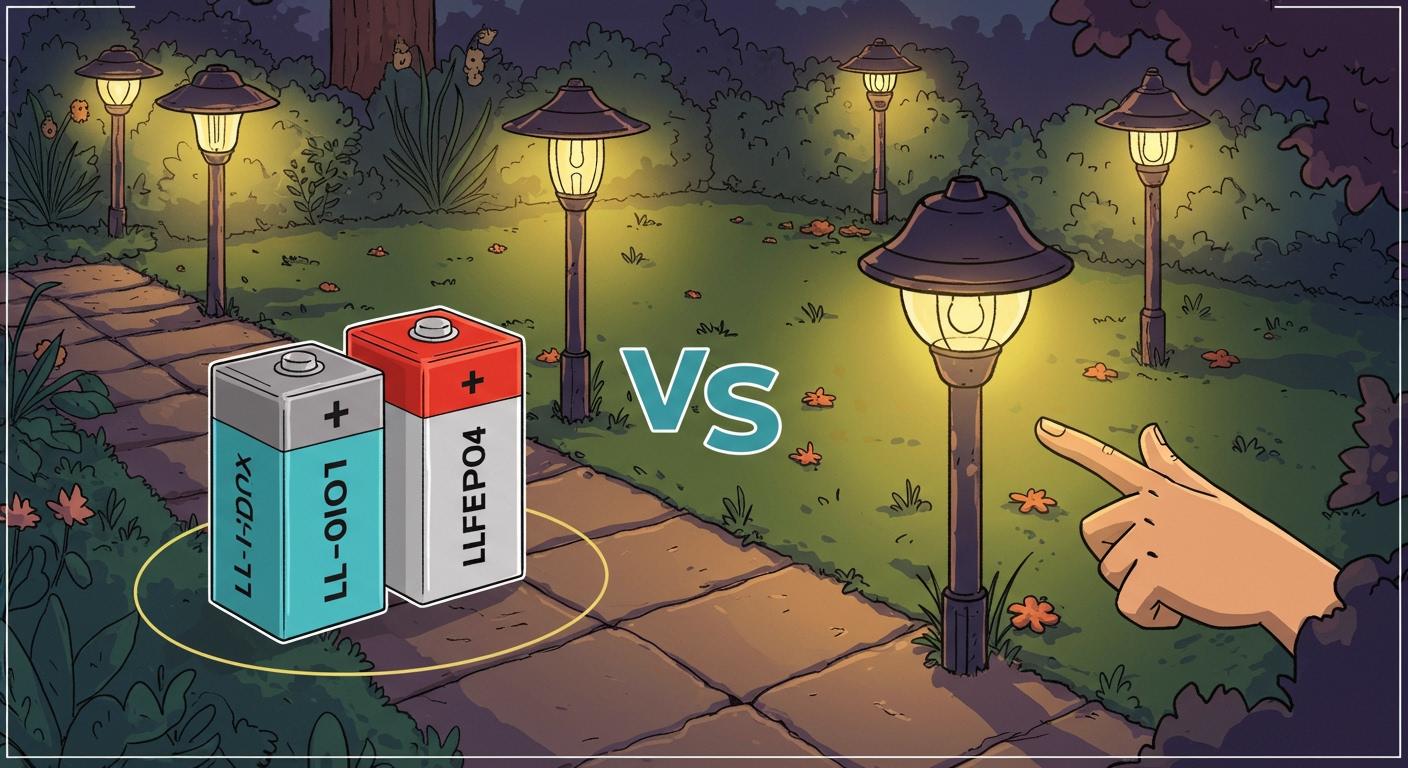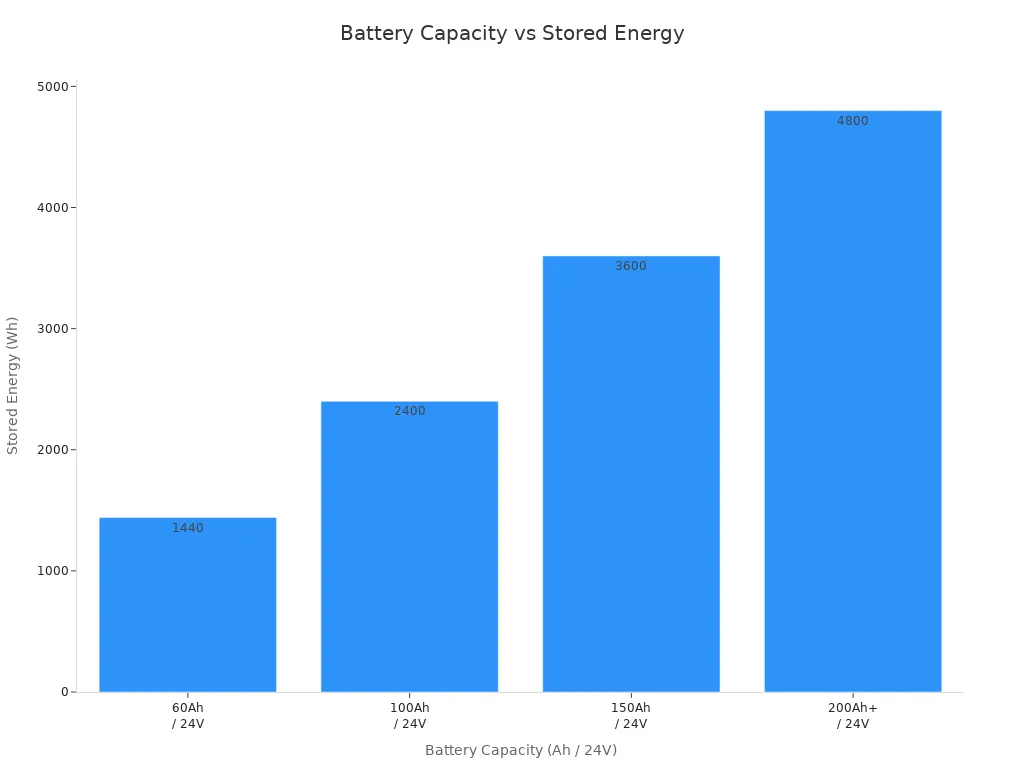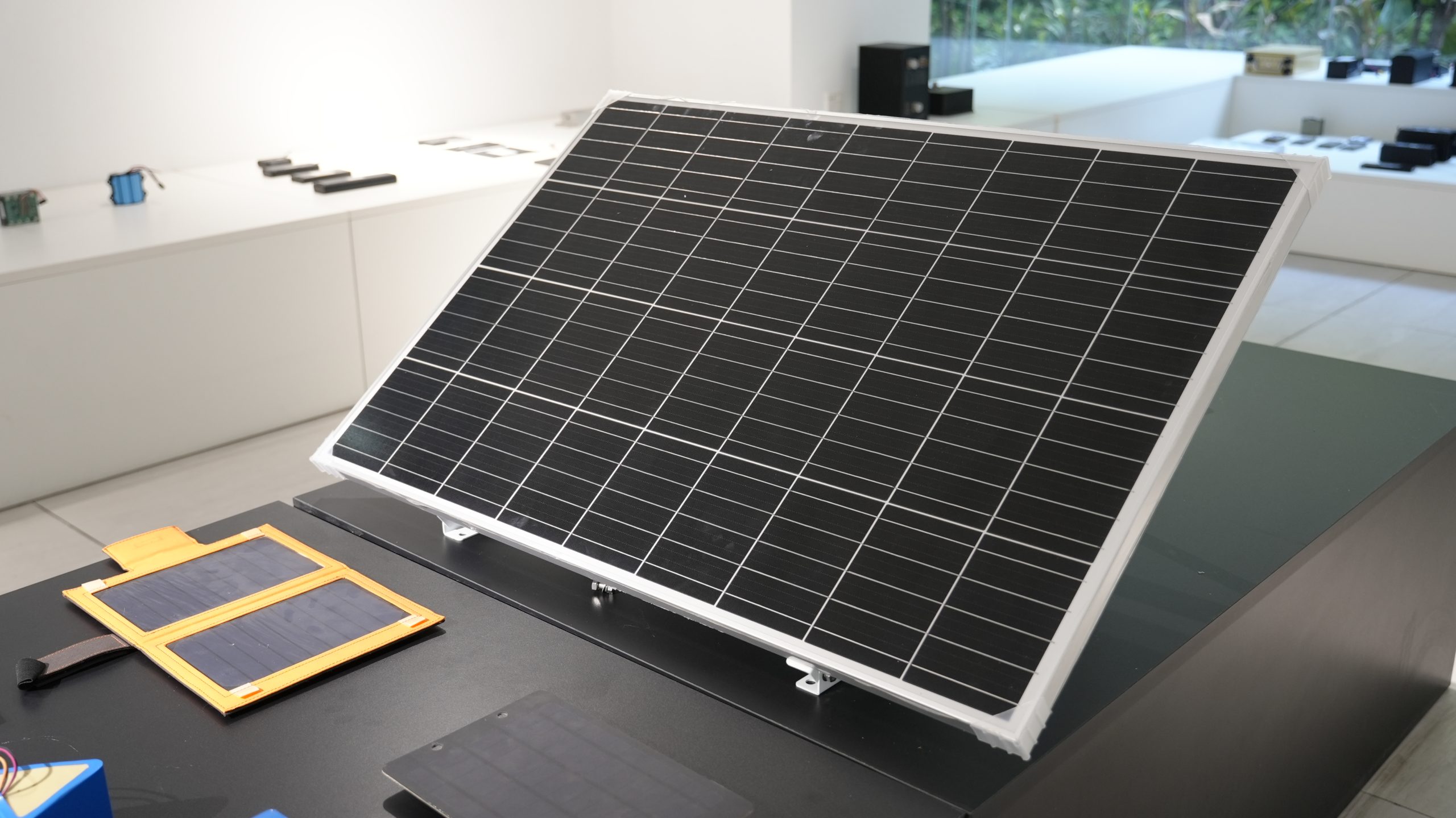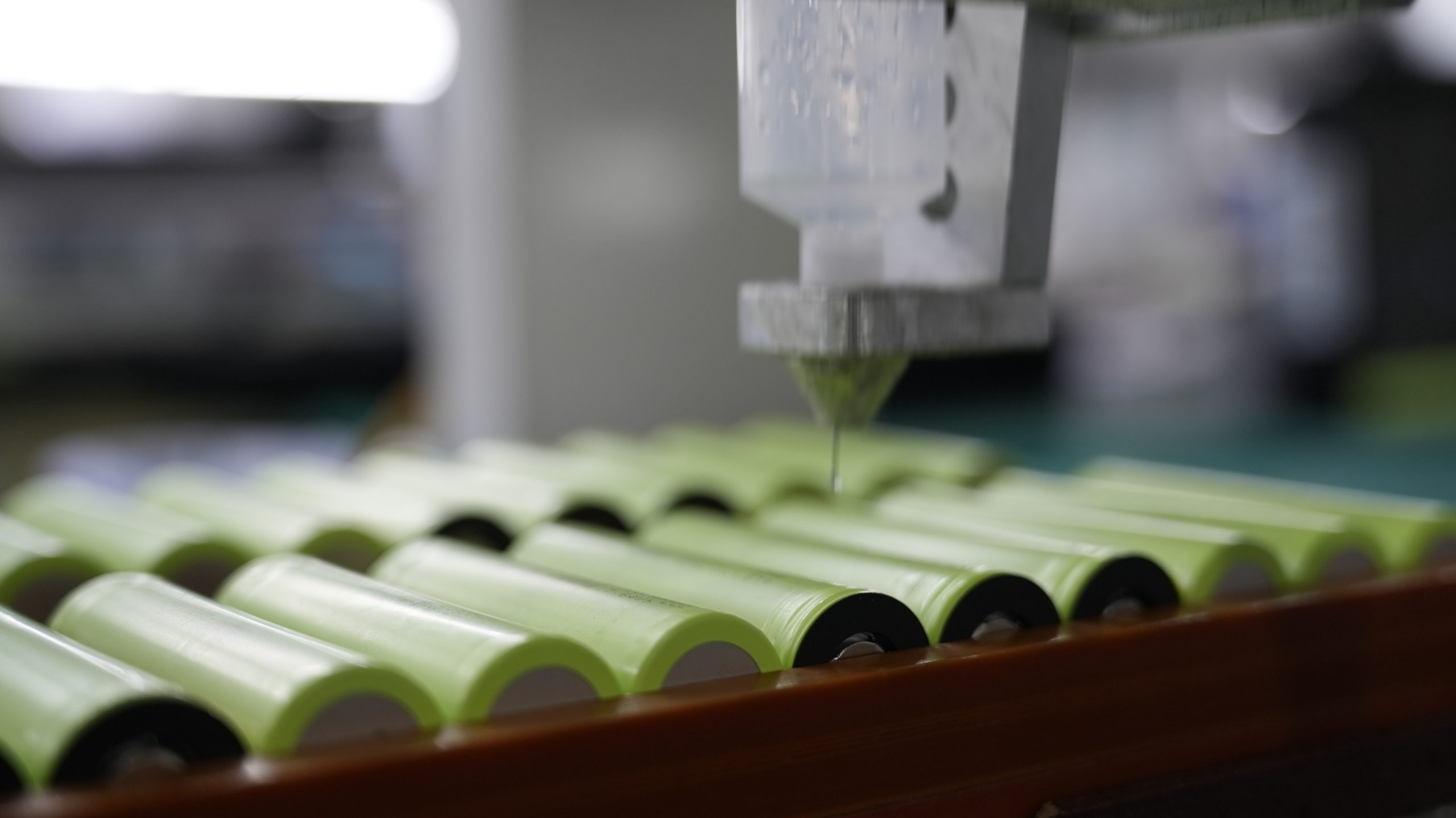
You need the right battery for garden lights if you want reliability and strong performance. LiFePO₄ batteries often work best for solar lights because they offer higher safety and greater longevity compared to standard lithium-ion batteries. Many B2B projects choose LiFePO₄ due to its stable voltage and robust chemistry. Choosing the right battery helps your lighting systems last longer and stay safe outdoors.
Key Takeaways
LiFePO₄ batteries are the best choice for garden lights due to their long lifespan and safety features. They can last up to 2,000 cycles, making them reliable for outdoor use.
Always match the battery’s voltage and capacity to your lighting system’s requirements. This ensures optimal brightness and runtime for your solar lights.
Consider the weatherproofing of batteries. LiFePO₄ batteries resist moisture and extreme temperatures, making them ideal for outdoor environments.
Evaluate the long-term value of batteries. LiFePO₄ batteries may have a higher upfront cost but save money over time due to their durability and lower maintenance needs.
Recycle used batteries properly. Take LiFePO₄ batteries to certified recycling centers to support sustainability and reduce environmental impact.
Part1: Choosing the Right Battery
1.1 Quick Recommendation
When you select a battery for garden lights, you want a solution that balances safety, performance, and durability. For most commercial outdoor lighting projects, LiFePO₄ batteries stand out as the top choice. These batteries offer stable voltage, long cycle life, and excellent resistance to harsh weather. You can rely on them for consistent performance in both small garden paths and large industrial sites.
Tip: Always match the battery voltage and capacity to your lighting system’s requirements. This ensures optimal brightness and runtime for your solar lights.
1.2 Key Factors for Garden Lights
You need to consider several practical considerations for choosing a solar battery in outdoor lighting projects. The right decision helps your system run reliably and efficiently.
Voltage and capacity must align with your lighting system. Higher capacity (measured in mAh or Ah) means longer runtime and brighter lights.
Brand reputation matters. Trusted brands reduce the risk of battery failure and ensure consistent quality.
Weatherproofing is essential. Outdoor batteries should resist moisture and extreme temperatures to prevent damage.
Battery Capacity (Ah) | Stored Energy (Wh) | Common Applications |
|---|---|---|
60Ah / 24V | 1,440 Wh | Low-power fixtures, garden paths, parks |
100Ah / 24V | 2,400 Wh | Medium LED lights, commercial walkways |
150Ah / 24V | 3,600 Wh | Multi-head poles, wide roadways |
200Ah+ / 24V | ≥4,800 Wh | Large industrial areas, remote zones |

Battery capacity directly affects how long your lights stay illuminated after sunset. For example, a 2000mAh battery can provide up to 8 hours of light in summer, but only about 5 hours in winter. High-capacity batteries (3000mAh or more) help maintain steady performance during cloudy days by storing extra energy.
Note: Always check the specifications of your lighting system to ensure the battery provides the desired illumination duration.
You should focus on these factors to maximize the reliability and efficiency of your garden lighting project.
Part2: LiFePO₄ vs Lithium-ion Overview

2.1 LiFePO₄ Batteries
You often see LiFePO₄ batteries used in solar-powered garden lights and industrial lighting systems. LiFePO₄, also known as lithium iron phosphate, provides a stable platform voltage of 3.2V per cell. This chemistry stands out for its high safety and long cycle life. You can expect up to 2,000 charge cycles, which means your battery can last up to 10 years in outdoor environments.
LiFePO₄ batteries handle high temperatures well and resist thermal runaway. You can use them in infrastructure projects, security systems, and robotics where reliability matters. The energy density is lower than some other lithium chemistries, but the trade-off is greater safety and longevity. You get consistent performance even in harsh weather.
LiFePO₄ batteries are less volatile and hold a charge for up to 350 days, making them ideal for solar garden lights that need dependable power storage.
2.2 Lithium-ion Batteries
Lithium-ion batteries include several chemistries, such as NMC (Nickel Manganese Cobalt), LCO (Lithium Cobalt Oxide), and LMO (Lithium Manganese Oxide). Most lithium-ion batteries offer higher energy density, which means you get more power in a lighter package. The platform voltage for NMC cells is typically 3.6V, which supports brighter lighting and compact battery packs.
You find lithium-ion batteries in consumer electronics, medical devices, and industrial automation. These batteries deliver strong performance but have a shorter cycle life—usually 300 to 500 cycles, or about 2 to 3 years. Lithium-ion batteries should not exceed 140°F, so they may not suit outdoor projects in extreme climates.
Below is a technical comparison table for LiFePO₄ vs NMC lithium batteries:
Chemistry | Platform Voltage | Energy Density (Wh/kg) | Cycle Life (cycles) | Application Scenarios |
|---|---|---|---|---|
LiFePO₄ | 3.2V | 90-120 | 1500-2000 | Solar lights, robotics, infrastructure |
NMC (Li-ion) | 3.6V | 150-220 | 300-1000 | Medical, consumer electronics, industrial |
You should consider the main differences in chemistry, voltage, and application suitability when choosing between LiFePO₄ vs lithium-ion. LiFePO₄ batteries have lower nominal voltage but offer higher safety and longevity. Lithium-ion batteries provide higher energy density and lighter weight, which suits portable devices and high-power applications.
Here is a summary table for solar-powered garden lights:
Feature | LiFePO₄ | Lithium-ion |
|---|---|---|
Safety | Less volatile, safer to use | More volatile |
Lifespan | 300-500 charge cycles, 2-3 years | |
Energy Density | Lower than lithium-ion | Higher than LiFePO₄ |
Weight | Heavier due to more cells needed | Lighter due to higher density |
Temperature Range | Can be used in high temperatures | Should not exceed 140°F |
Charge Retention | Holds charge for up to 350 days | Holds charge for up to 300 days |
Tip: For B2B lighting projects, you should match battery chemistry to your application needs. LiFePO₄ batteries excel in outdoor, high-reliability scenarios, while lithium-ion batteries suit portable and high-energy applications.
Part3: Safety of LiFePO₄ Batteries
When you select batteries for outdoor lighting or industrial projects, safety becomes a top priority. LiFePO4 batteries, also known as lithium iron phosphate, offer high safety and reliability for demanding environments. You can trust these batteries to deliver a long lifespan and consistent performance, even in harsh conditions. While both lithium-ion batteries and LiFePO4 batteries are safe when used correctly, LiFePO4 stands out for its superior durability and resistance to battery fires.
3.1 Thermal Stability
Thermal stability is a key advantage of LiFePO4. You benefit from a chemistry that resists overheating and thermal runaway. Lithium-ion batteries, such as NMC and LCO, can reach high temperatures during rapid charging or discharging. This increases the risk of battery fires in some applications. LiFePO4 batteries maintain a stable temperature profile, even under heavy loads or in hot climates. This makes them ideal for infrastructure, security systems, and robotics where reliability and durability are critical.
Chemistry | Platform Voltage | Energy Density (Wh/kg) | Cycle Life (cycles) | Thermal Stability | Application Scenarios |
|---|---|---|---|---|---|
LiFePO4 | 3.2V | 90-120 | 1500-2000 | Excellent | Solar lights, robotics, infrastructure |
NMC (Li-ion) | 3.6V | 150-220 | 300-1000 | Moderate | Medical, industrial, electronics |
LCO (Li-ion) | 3.6V | 150-200 | 300-500 | Low | Consumer electronics |
LiFePO4 batteries provide high safety and a longer lifespan, making them a preferred choice for outdoor and industrial battery packs.
3.2 Overcharge Protection
Overcharge protection is another area where LiFePO4 batteries excel. You reduce the risk of damage and extend the expected battery lifetime by choosing lithium iron phosphate. The chemistry naturally resists overcharging, which helps prevent capacity loss and ensures a long cycle life. Lithium-ion batteries require advanced battery management systems to avoid overcharge, but LiFePO4 offers built-in durability and reliability.
LiFePO4 batteries tolerate overcharge better than most lithium-ion chemistries.
You experience fewer failures and less maintenance, which supports long-term durability.
The long lifespan and high safety of LiFePO4 batteries contribute to lower operational costs for B2B projects.
For outdoor lighting, security, and industrial systems, you gain peace of mind with LiFePO4’s superior safety features and robust durability.
Part4: Lifespan and Reliability
4.1 Cycle Life
You need a battery that delivers consistent performance and long service life for garden lights and outdoor projects. LiFePO4 batteries stand out because they maintain capacity over thousands of cycles. Most lithium-ion batteries, such as NMC or LCO, offer a shorter cycle life. You often see lithium-ion batteries reach 300 to 1,000 cycles before significant capacity loss. In contrast, LiFePO4 batteries can last 1,500 to 2,000 cycles or more, making them a reliable energy storage solution for home energy storage and industrial lighting.
Chemistry | Platform Voltage | Energy Density (Wh/kg) | Cycle Life (cycles) | Application Scenarios |
|---|---|---|---|---|
LiFePO4 | 3.2V | 90-120 | 1,500-2,000 | Garden lights, home energy storage, infrastructure |
NMC (Li-ion) | 3.6V | 150-220 | 300-1,000 | Medical, robotics, consumer electronics |
LCO (Li-ion) | 3.6V | 150-200 | 300-500 | Consumer electronics, industrial |
You benefit from a battery that holds its capacity longer, reducing replacement costs and maintenance. This makes LiFePO4 batteries a preferred choice for B2B lighting projects that demand reliability.
4.2 Outdoor Performance
Outdoor environments challenge battery performance. You need a solution that withstands temperature swings, moisture, and mechanical stress. LiFePO4 batteries excel in these conditions. They resist heat build-up and maintain stable performance, even in extreme temperatures.
LiFePO4 batteries exhibit superior performance in extreme outdoor temperatures compared to traditional lithium-ion batteries, particularly in terms of safety, longevity, and efficiency. One of the most significant advantages of LiFePO4 batteries is their reduced susceptibility to thermal runaway, making them far less likely to catch fire or explode, even in situations where other batteries might fail.
LiFePO4 batteries are more stable and resist heat build-up that triggers thermal runaway.
They do not produce oxygen as a byproduct during discharge, reducing fire risk.
Their robust structural integrity allows them to withstand higher temperatures and mechanical abuse.
When you use lithium-ion batteries outdoors, you may see faster capacity loss in hot weather. Lithium-ion batteries also stop charging below freezing, which limits their use in cold climates. LiFePO4 batteries provide a safer, more reliable energy storage solution for home energy storage, security systems, and infrastructure projects.
When the temperature goes below freezing, just about any lithium battery will automatically cease charging. For hot temperatures, elevated conditions lead to faster loss of capacity, impacting longevity. This highlights the limitations of traditional lithium-ion batteries in extreme outdoor temperatures.
You ensure long-term performance and safety for your lighting systems by choosing LiFePO4 batteries. Their reliability in harsh environments makes them the top choice for B2B outdoor lighting and home energy storage applications.
Part5: Performance Factors
5.1 Voltage and Energy Density
When you select a battery for garden lighting, you need to consider both voltage and energy density. These factors determine how efficiently your lighting system operates and how much energy it can store in a compact space. LiFePO4 batteries provide a platform voltage that ranges from 2.00V to 3.65V per cell. In contrast, lithium-ion batteries, such as NMC or LCO, typically offer a higher average voltage range of 3.6V to 3.7V per cell. This higher voltage can support brighter lighting or more compact battery packs.
Energy density measures how much energy a battery can store for its weight or volume. LiFePO4 batteries deliver an energy density between 90–160 Wh/kg and about 325 Wh/L. Lithium-ion batteries usually offer higher energy density, making them lighter and more suitable for applications where weight matters, such as robotics or medical devices. However, for outdoor lighting and infrastructure, the slightly lower energy density of LiFePO4 is balanced by its superior safety and longer cycle life.
Battery Type | Average Voltage Range | Energy Density |
|---|---|---|
LiFePO4 | 2.00V to 3.65V | 90–160 Wh/kg, 325 Wh/L |
Lithium-ion | 3.6 to 3.7V | Higher than LiFePO4 |
Note: Always match the battery voltage to your lighting system’s requirements to ensure optimal performance and safety.
5.2 Charge/Discharge Rate
Charge and discharge rates play a critical role in how your battery performs in real-world conditions. LiFePO4 batteries support stable charge and discharge rates, which helps maintain consistent lighting output throughout the night. These batteries can handle high current loads without significant heat buildup, making them ideal for industrial lighting, security systems, and infrastructure projects.
Lithium-ion batteries, while capable of fast charging, require careful management to prevent overheating or capacity loss. You should always use a reliable battery management system (BMS) to monitor and control charge/discharge cycles. A BMS protects your lithium battery pack from overcharging, deep discharge, and thermal issues. For more details on BMS and protection circuit modules, visit this resource.
LiFePO4 batteries offer a longer cycle life even under frequent charge/discharge cycles.
Lithium-ion batteries may degrade faster if exposed to rapid charging or high discharge rates.
Tip: For B2B lighting projects, always specify a battery with a robust BMS to maximize safety and reliability, especially when using lithium chemistries in demanding environments.
Part6: Cost and Value
6.1 Upfront Cost
When you plan a garden lighting project, you need to consider the initial investment for battery packs. LiFePO4 batteries often cost more at the start because manufacturers use specialized materials and advanced production methods. You may notice this difference when you compare battery quotes for infrastructure, security systems, or industrial lighting.
LiFePO4 batteries have a higher initial cost due to specialized materials and production.
Lithium-ion batteries, such as NMC or LCO, usually offer a lower upfront price, making them attractive for projects with tight budgets.
Here is a comparison table for typical battery costs and specifications:
Chemistry | Platform Voltage | Energy Density (Wh/kg) | Cycle Life (cycles) | Upfront Cost | Application Scenarios |
|---|---|---|---|---|---|
LiFePO4 | 3.2V | 90-120 | 1,500-2,000 | High | Garden lights, infrastructure, security systems |
NMC (Li-ion) | 3.6V | 150-220 | 300-1,000 | Moderate | Medical, robotics, industrial |
LCO (Li-ion) | 3.6V | 150-200 | 300-500 | Low | Consumer electronics, industrial |
You should weigh the upfront cost against the expected performance and reliability for your specific application.
6.2 Long-term Value
You gain long-term value when you choose batteries that last longer and require less maintenance. LiFePO4 batteries deliver a longer cycle life, which means you replace them less often. This reduces downtime and labor costs for B2B projects in outdoor lighting, infrastructure, and security systems.
Lithium-ion batteries, while cheaper at first, may need replacement after only a few years. You spend more on maintenance and battery swaps over time. LiFePO4 batteries help you lower the total cost over the battery’s life because they maintain capacity and performance for up to a decade.
LiFePO4 batteries offer fewer failures and longer service intervals.
You save money on replacements and reduce operational disruptions.
The higher initial investment pays off with reliable performance and lower long-term expenses.
For B2B garden lighting projects, you maximize value by selecting battery packs that balance upfront cost with durability and reliability.
Part7: Environmental Impact

7.1 Sustainability
You play a key role in making your garden lighting projects more eco-friendly by choosing the right battery chemistry. LiFePO4 batteries stand out as a sustainable option for B2B lighting systems. These batteries do not contain cobalt or heavy metals, which lowers their environmental risk. You also benefit from a higher margin of safety for residential and commercial use.
The production of lithium batteries creates a high carbon footprint, especially when factories use coal-based electricity.
Many battery manufacturing plants operate in regions with heavy coal reliance, such as China.
Switching to cleaner energy sources during production can greatly reduce the carbon footprint of lithium battery packs.
LiFePO4 batteries support your sustainability goals because they are recyclable and safer for the environment. You can learn more about sustainable battery practices in our approach to sustainability. If you want to ensure your supply chain avoids conflict minerals, review our conflict minerals statement.
Chemistry | Platform Voltage | Energy Density (Wh/kg) | Cycle Life (cycles) | Cobalt/Heavy Metals | Application Scenarios |
|---|---|---|---|---|---|
LiFePO4 | 3.2V | 90-120 | 1,500-2,000 | No | Garden lights, infrastructure, security systems |
NMC (Li-ion) | 3.6V | 150-220 | 300-1,000 | Yes | Medical, robotics, industrial |
LCO (Li-ion) | 3.6V | 150-200 | 300-500 | Yes | Consumer electronics, industrial |
Choosing LiFePO4 batteries helps you build safer, more sustainable, and eco-friendly lighting solutions.
7.2 Recycling
You should never dispose of LiFePO4 batteries with regular waste. Instead, take them to certified recycling centers. The recycling process includes safely discharging the batteries, shredding them, and extracting valuable materials like iron, phosphate, and lithium for reuse. This practice reduces environmental impact and supports a circular economy.
Lithium-ion batteries, such as NMC and LCO, present more recycling challenges:
Complex recycling processes make it hard to recover valuable materials.
Improper disposal can cause environmental hazards, as these batteries may leak toxic substances in landfills.
Low recycling rates mean many lithium-ion batteries end up as e-waste.
You help protect the environment and improve sustainability by following proper recycling procedures for all lithium battery packs.
Part8: Decision Guide
8.1 Project Needs
When you plan a garden lighting project for commercial or municipal use, you need to match your battery choice to your specific requirements. Start by identifying the most important factors for your application:
Battery Life: Choose a battery that supports long-term operation. Lifepo4 batteries deliver up to 2,000 cycles, making them ideal for projects that require minimal maintenance.
Compatibility: Ensure your battery works with existing control systems and infrastructure. Lifepo4 batteries offer a platform voltage of 3.2V per cell, which fits many outdoor lighting designs.
Durability: Outdoor environments can be harsh. Lifepo4 batteries withstand temperature swings, moisture, and mechanical stress better than most lithium-ion chemistries.
Environmental Considerations: Select batteries that comply with local safety standards and sustainability practices. Lifepo4 batteries do not contain cobalt or heavy metals, supporting your sustainability goals.
Tip: Always review your lamp’s voltage and current needs. Calculate the right battery size and consider usage patterns. Continuous operation may require larger capacity, while intermittent use allows for smaller batteries.
8.2 Supplier Selection
Selecting the right supplier ensures your lithium battery packs meet your project’s demands. Leading suppliers recommend batteries based on technical criteria and application scenarios. Use the table below to compare key factors:
Criteria | Description |
|---|---|
Voltage and Capacity | Match the battery’s voltage and capacity to your light fixture’s requirements. |
Incompatibility Risks | Avoid using incompatible batteries to prevent performance issues or damage. |
You should also evaluate suppliers based on their commitment to sustainability and ethical sourcing. Lifepo4 batteries support responsible sourcing because they avoid conflict minerals. Review your supplier’s conflict minerals statement and approach to sustainability to ensure compliance.
Follow these steps for a successful selection process:
Understand your lamp’s voltage and current needs.
Calculate the correct battery size for your application.
Consider environmental and usage factors to ensure efficiency, safety, and reliability.
Selecting the best lithium battery for LED lights requires knowledge of battery chemistries, energy density, cycle life, and application scenarios. Lifepo4 batteries offer a strong balance of safety, lifespan, and value for B2B garden lighting projects.
You want the right battery for your solar lights to ensure safety, reliability, and longevity. LiFePO₄ batteries stand out as the ultimate battery solution for B2B garden lighting projects. These batteries deliver longer lifespan, better safety, and high efficiency for solar lights. See the main reasons below:
Reason | Description |
|---|---|
Longer lifespan | Up to 2,000–5,000 cycles, far more than other chemistries. |
Better safety | No risk of explosion or thermal runaway in solar lights. |
High efficiency | Charges quickly, even on cloudy days, for reliable solar lights. |
You should always assess your project’s needs to choose the right battery for your solar lights. The right battery ensures your lighting system performs at its best and lasts for years.
FAQ
What makes LiFePO4 batteries safer for outdoor lighting?
LiFePO4 batteries resist thermal runaway and overcharging. You benefit from a stable platform voltage of 3.2V per cell. This chemistry does not release oxygen during failure, which reduces fire risk in infrastructure and security systems.
How do LiFePO4 and NMC batteries compare for cycle life and energy density?
Chemistry | Platform Voltage | Energy Density (Wh/kg) | Cycle Life (cycles) | Application Scenarios |
|---|---|---|---|---|
LiFePO4 | 3.2V | 90–120 | 1,500–2,000 | Garden lights, infrastructure |
NMC | 3.6V | 150–220 | 300–1,000 | Medical, robotics, industrial |
You get longer cycle life with LiFePO4. NMC offers higher energy density.
Can you use lithium-ion batteries in extreme temperatures?
You can use LiFePO4 batteries in high and low temperatures. NMC and LCO batteries lose capacity faster in heat and stop charging below freezing. For outdoor or industrial projects, LiFePO4 provides better reliability.
Why should you choose LiFePO4 for B2B lighting projects?
You gain longer service life, lower maintenance, and higher safety with LiFePO4. This chemistry fits infrastructure, security, and industrial settings. You reduce replacement costs and improve system uptime.
What is the best way to recycle lithium battery packs?
You should send used lithium battery packs to certified recycling centers. These facilities safely extract lithium, iron, and phosphate. Proper recycling supports sustainability and reduces environmental impact for your business.




